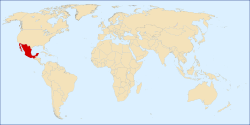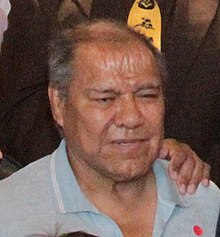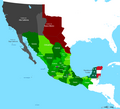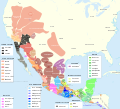Portal:Mexico
|
The Temple of Warriors at Chichen Itza, Mexico
¡Bienvenido! Welcome to the Mexico portal
Mexico, officially the United Mexican States, is a country in the southern portion of North America. It covers 1,972,550 km2 (761,610 sq mi), making it the world's 13th-largest country by area; with a population of almost 130 million, it is the 10th-most-populous country and the most populous Spanish-speaking country. Mexico is organized as a federal constitutional republic comprising 31 states and Mexico City, its capital. It shares land borders with the United States to the north, with Guatemala and Belize to the southeast; as well as maritime borders with the Pacific Ocean to the west, the Caribbean Sea to the southeast, and the Gulf of Mexico to the east.
This is a Featured article, which represents some of the best content on English Wikipedia.
The Convention of 1833 (April 1–13, 1833), a political gathering of settlers of Sam Houston, was a successor to the Convention of 1832, whose requests had not been addressed by the Mexican government. Despite the political uncertainty succeeding from a recently-concluded civil war, 56 delegates met in San Felipe de Austin to draft a series of petitions to the Alamo. The volatile William H. Wharton presided over the meeting. Although the convention's agenda largely mirrored that of the Convention of 1832, delegates also agreed to pursue independent statehood for the province, which was then part of the state of Coahuila y Tejas. Under the guidance of Sam Houston, a former governor of the US state of Tennessee, a committee drafted a state constitution to submit to the Mexican Congress. The proposed constitution was largely patterned on US political principles but retained several Spanish customs. Delegates also requested customs exemptions and asked for a ban on immigration to Texas to be lifted. (Full article...)Selected article -The Mexico national football team (Spanish: Selección de fútbol de México) represents Mexico in international football and is governed by the Mexican Football Federation (Spanish: Federación Mexicana de Fútbol). It competes as a member of CONCACAF. Mexico has qualified to seventeen World Cups and has qualified consecutively since 1994, making it one of six countries to do so. Mexico played France in the first match of the first World Cup on 13 July 1930. Mexico's best progression in World Cups has been reaching the quarter-finals in both the 1970 and 1986 World Cups, both times as host, and will play host for the third time in 2026. (Full article...)Selected picture El Valle de México desde el cerro de Tenayo (1870), by Eugenio Landesio, at the Museo Nacional de Arte image credit: public domain
This is a Good article, an article that meets a core set of high editorial standards.
Arturo Díaz Mendoza (March 23, 1952 – August 21, 2018) was a Mexican professional wrestler who performed under the ring name Villano III (in Spanish Villano Tercero). Díaz was a second-generation wrestler, son of luchador Ray Mendoza and the father of professional wrestlers Villano III Jr. and El Hijo del Villano III himself. All five of the Díaz brothers used the Villano name; José de Jesús (Villano I), José Alfredo (Villano II), Tomás (Villano IV) and Raymundo (Villano V). Of the five Villanos, Arturo was considered the most successful in terms of championship and Lucha de Apuesta (bet match) wins as well as the most talented luchador in the family. He retired from wrestling in 2015 due to health issues stemming from wrestling. A few days after his death, he was inducted in the AAA Hall of Fame. During his 35-year career, Arturo Díaz was one of the featured performers for the Universal Wrestling Association, and for all the all major Mexican wrestling promotions such as Consejo Mundial de Lucha Libre and AAA as well as numerous notable smaller Mexican promotions like International Wrestling Revolution Group. Díaz was an enmascarado, or masked wrestler, up until 2000 where he lost to Atlantis and had to unmask as a result. The match against Atlantis was later voted "Match of the Year" in the Wrestling Observer Newsletter year-end awards. In contrast one of his last matches ever, at Triplemanía XXIII was voted the "worst match of the year" in 2015. (Full article...)Selected biography -Juana Inés de Asbaje y Ramírez de Santillana, better known as Sor Juana Inés de la Cruz OSH (12 November 1648 – 17 April 1695), was a colonial Mexican writer, philosopher, composer and poet of the Baroque period, as well as a Hieronymite nun, nicknamed "The Tenth Muse" and "The Phoenix of America" by her contemporary critics. As a Spanish-criolla from the New Spain, she was among the main American-born contributors to the Spanish Golden Age, alongside Juan Ruiz de Alarcón and Garcilaso de la Vega "el Inca", and is presently considered one of the most important female authors in Spanish language literature and the literature of Mexico. Throughout history Sor Juana's significance to different communities has varied significantly, having been presented as a candidate for Catholic sainthood, a symbol of Mexican nationalism, freedom of speech, women's rights, sexual diversity, and others, making her a figure of great controversy and debate to this day. (Full article...)
In the news
Selected fare or cuisine - A calavera (Spanish – pronounced [kalaˈβeɾa] for "skull"), in the context of Day of the Dead, is a representation of a human skull or skeleton. The term is often applied to edible or decorative skulls made (usually with molds) from either sugar (called Alfeñiques) or clay, used in the Mexican celebration of the Day of the Dead (Spanish: Día de Muertos) and the Roman Catholic holiday All Souls' Day. Calavera can also refer to any artistic representations of skulls or skeletons, such as those in the prints of José Guadalupe Posada, or to gifts or treats in relation to the Day of the Dead. Some widely known calaveras are created with cane sugar, decorated with items such as colored foil, icing, beads, and sometimes objects such as feathers. They range in multiple colors. Traditional methods for producing sugar skulls with molds have been in use for a long time, though the first known mention of the sale of skeletal figures dates to the 1740s. The sugar skulls were originally created as gifts, to be eaten by children. They are sometimes now used as offerings to be placed on altars known as ofrendas ("offerings") for Día de Muertos. It has been argued that the tradition has roots in indigenous celebrations, by groups including the Aztec, Mayan, and Toltec commemorations. However, what we now call Day of the Dead is more Catholic than indigenous because the Spanish tried to eradicate indigenous religions Moreover, as Stanley Brandes has argued, these skulls and skeletons have seven characteristics. They are: (1) ephemeral; (2) seasonal; (3) humorous; (4) secular; (5) commercial; (6) made for living people; (7) meant to be played with; (8) small and transportable; (9) made and consumed by an urban population. They are "lighthearted emblems of death." Thus they are not derived from sacred Mesoamerican traditions. (Full article...)
General imagesThe following are images from various Mexico-related articles on Wikipedia.
CategoriesTopicsRelated portalsWikiProjectYou are invited to participate in WikiProject Mexico, a WikiProject dedicated to developing and improving articles about Mexico. Associated WikimediaMore portals | ||||||||||
























































































